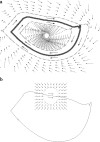Implications of assist-as-needed robotic step training after a complete spinal cord injury on intrinsic strategies of motor learning
- PMID: 17035542
- PMCID: PMC6674681
- DOI: 10.1523/JNEUROSCI.2266-06.2006
Implications of assist-as-needed robotic step training after a complete spinal cord injury on intrinsic strategies of motor learning
Abstract
Robotic training paradigms that enforce a fixed kinematic control might be suboptimal for rehabilitative training because they abolish variability, an intrinsic property of neuromuscular control (Jezernik et al., 2003). In the present study we introduce "assist-as-needed" (AAN) robotic training paradigms for rehabilitation of spinal cord injury subjects. To test the efficacy of these robotic control strategies to teach spinal mice to step, we divided 27 adult female Swiss-Webster mice randomly into three groups. Each group was trained robotically by using one of three control strategies: a fixed training trajectory (Fixed group), an AAN training paradigm without interlimb coordination (Band group), and an AAN training paradigm with bilateral hindlimb coordination (Window group). Beginning at 14 d after a complete midthoracic spinal cord transection, the mice were trained daily (10 min/d, 5 d/week) to step on a treadmill 10 min after the administration of quipazine (0.5 mg/kg), a serotonin agonist, for a period of 6 weeks. During weekly performance evaluations, the mice trained with the AAN window paradigm generally showed the highest level of recovery as measured by the number, consistency, and periodicity of steps during the testing sessions. In all three measurements there were no significant differences between the Band and the Fixed training groups. These results indicate that the window training approach, which includes loose alternating interlimb coordination, is more effective than a fixed trajectory paradigm with rigid alternating interlimb coordination or an AAN paradigm without any interlimb constraints in promoting robust postinjury stepping behavior.
Figures



References
-
- Antri M, Mouffle C, Orsal D, Barthe JY. 5-HT1A receptors are involved in short- and long-term processes responsible for 5-HT-induced locomotor function recovery in chronic spinal rat. Eur J Neurosci. 2003;18:1963–1972. - PubMed
-
- Barbeau H, Rossignol S. Recovery of locomotion after chronic spinalization in the adult cat. Brain Res. 1987;412:84–95. - PubMed
-
- Cai LL, Fong AJ, Otoshi CK, Liang YQ, Cham JG, Zhong H, Roy RR, Edgerton VR, Burdick JW. Effects of consistency vs variability in robotically controlled training of stepping in adult spinal mice. Proc Int Conf Rehabil Robotics; 2005. pp. 575–579.
-
- de la Torre JC, Goldsmith HS. Collagen-omental graft in experimental spinal cord transection. Acta Neurochir (Wien) 1990;102:152–163. - PubMed
-
- de Leon RD, Hodgson JA, Roy RR, Edgerton VR. Full weight-bearing hindlimb standing following stand training in the adult spinal cat. J Neurophysiol. 1998;80:83–91. - PubMed
Publication types
MeSH terms
Grants and funding
LinkOut - more resources
Full Text Sources
Other Literature Sources
Medical
